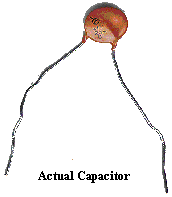
 A capacitor may be thought of as a pair of parallel
metal plates placed close together. Since no current can
flow between the plates they simply store an electrical
charge proportional to the voltage across them.
A capacitor may be thought of as a pair of parallel
metal plates placed close together. Since no current can
flow between the plates they simply store an electrical
charge proportional to the voltage across them.
When the voltage across a capacitor changes there
is a flow of charge (a current) in or out of the capacitor.
We may write this mathematically as
For fluctuating voltages
and currents this expression may be simplified by substituting
previous expressions v =
Vejwt
and i =
Iejwt
to give